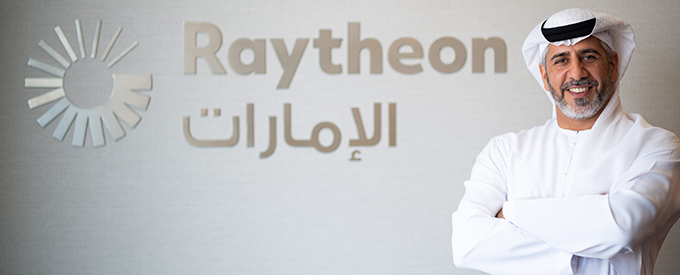2022-12-01
Raytheon’s KuRFS Expertly Breaks Through the Clutter
From the ground up, Raytheon’s Ku-band Radio Frequency System (KuRFS) is an agile and scalable digital sensor that can continually adapt to evolving and challenging threats. In an interview, Fahad Mohammed Al Mheiri, Deputy Managing Director for Raytheon Emirates, highlights how KuRFS started out as a sense-and-warn radar, but thanks to its precision targeting capabilities and reliable performance, its use has been expanded to air surveillance, counter-RAM and counter-UAS missions. Excerpts:
What distinguishes KuRFS from other radars?
Developed in partnership with the U.S. Army, the radar was originally built to help defeat rocket, artillery and mortar (RAM) attacks in the Afghanistan and Iraq wars. It was fielded in 2013 for a new mission – short-range air defence (SHORAD), and it has surpassed 1.6 million operational hours.
KuRFS uses active electronically scanned array (AESA) technology that enables the exact steering of its beam toward a threat. The radar owes its precise sensing and fire control to its operation on the Ku-band of the electromagnetic spectrum.
The Ku band’s short wavelengths produce significantly sharper image resolution than other parts of the electromagnetic spectrum. It enables the KuRFS radar to tell the difference between many small objects at once. It can even see and identify an incoming 9 mm bullet. That makes it optimal for picking small UAS out of a group of objects or clutter.
How many KuRFS radars are currently operational? How well is the system suited for Middle East countries?
Today, the U.S. Army operates nearly 60 KuRFS radars around the world, providing persistent 360-degree surveillance – detecting, tracking and discriminating airborne objects. Though it’s specifically used for SHORAD missions, KuRFS can see helicopters and planes up to and beyond 100 kilometres (62 miles).
KuRFS bolsters a layered defence by ensuring efficient and low-cost SHORAD operations. Warfighters can take it wherever they go, with confidence that the radar is up to the mission. Even as adversaries adapt from a single-threat environment to multiples to highly integrated swarms of drones, KuRFS meets that challenge.
Has the KuRFS been designed to work and integrate with multiple effectors?
Once KuRFS finds threats, it warns and cues defensive weapons to intercept them using kinetic effectors and non-kinetic engagement such as directed energy. Its ability to detect threats from long distances gives soldiers a stand-off distance for safety and ample time to make an engagement decision.
For counter-UAS engagements, KuRFS gives the Coyote effector superior sensing capability against a broad set of UAS threats over a long-range, detecting even the smallest class of drones out beyond 15 kilometres. It provides the operator integration with flexibility and a clear, accurate vision for quick decision-making to defeat the target threat.
KuRFS is integrated with more than 15 weapon systems, including Raytheon Missile & Defense’s land-based Phalanx weapon system, Coyote family of effectors and Phaser high-power microwave, as well as HELWS, a high-energy laser weapon system made by Raytheon Intelligence & Space, also a Raytheon Technologies business. KuRFS is integrated with the Forward Area Air Defense Command and Control system for the Army’s SHORAD system. And the radar also provides the cueing data for 50-caliber guns and 30mm cannons.
How does Raytheon intend to stay ahead of evolving threats by making use of the KuRFS capabilities?
From the ground up, KuRFS is an agile and scalable digital sensor, continually able to adapt to the evolving and most challenging SHORAD threats. While KuRFS started out as a sense-and-warn radar, its precision targeting capabilities and reliable performance have made it highly effective for expanded missions, such as air surveillance, counter-RAM and now, counter-UAS.
KuRFS continues to evolve to stay ahead of threats. Raytheon Missiles & Defense works closely with the Army to update and sustain the system for reliable performance and readiness in all environments where they operate.
What recent upgrades have been made to the KuRFS?
In partnership with the U.S. Army’s Integrated Fires and Rapid Capabilities Office, Raytheon Missiles & Defense showcased the capabilities of the Low, slow, small, unmanned aircraft system Integrated Defeat System (LIDS) during the U.S. Army summer test period.
LIDS is a U.S. Army-developed counter-unmanned aircraft system solution. It integrates KuRFS and the Coyote family of effectors with Northrop Grumman’s Forward Area Air Defence Command and Control system and an electronic warfare system made by Syracuse Research Corporation.
Building off the performance of the 2021 summer test period and incorporating direct input from warfighters operating the systems, Raytheon utilised real-world data to quickly enhance the systems and further improve the performance and dependability of LIDS. During the tests, LIDS detected and defeated drones and drone swarms varying in size, manoeuvrability, and range, validating those updates and reaffirming the effectiveness of the solution.
How do you describe the KuRFS in three words and why?
Precise: The Ku-band of the electromagnetic spectrum supports the detection of small objects out of the clutter. This is what makes KuRFS an ideal sensor for the C-UAS mission.
Persistent: KuRFS provides persistent tracking for threat detection. And, as a 360-degree radar, it’s tracking in all directions at all times.
Multi-mission: KuRFS can be deployed to stand sentry by itself in a “sense-and-warn” mission so that if a base is under attack, the radar gives troops enough time to seek cover.


No Comments